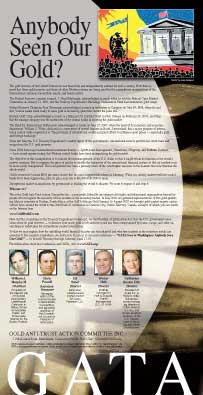You are here
Bailout implementation is all fantastic conflict of interest and patronage
Paulson Recruits Asset Managers to Stop Loss of 'Precious Days'
By Rebecca Christie and Robert Schmidt
Bloomberg News
Friday, October 3, 2008
http://www.bloomberg.com/apps/news?pid=20601087&sid=aczLjF35rxQM&refer=home
WASHINGTON -- Treasury Secretary Henry Paulson is hiring as many as 10 asset-management firms to join the lawyers and bankers he is recruiting to jumpstart the government's new $700 billion bank-rescue program.
The Treasury began implementing the plan within an hour of the House of Representatives vote giving Paulson the extraordinary powers he had sought to combat the U.S. financial crisis. Paulson is seeking to assemble a team to determine which toxic securities to target, how to value them, and how to arrange purchases.
"This is something that, for a typical company, would take no less than five years," said Lynn Turner, a former chief accountant at the Securities and Exchange Commission. "Anyone who thinks they can do this in two weeks is insane."
Ed Forst, the former Goldman Sachs Group Inc. executive Paulson hired to head the transition team, started work last week and is charged with establishing the new Office of Financial Stability.
"Paulson did not want to lose precious days waiting," said Howard Glaser, a former chief legal adviser of the Department of Housing and Urban Development.
Treasury officials said Forst, who was given a contract worth $5,000, is likely to stay for several weeks before returning to Harvard University, where he helps manage the $34.9 billion endowment.
... Outside Contractors
Lobbyists say the Treasury wants to run the program as much as possible with outside contractors. Career Treasury staff would handle the administrative tasks.
While the department will bypass some government contracting rules, as the legislation allows, it says it plans to put a formal and transparent process in place to hire the private-sector help. The department may also tap the Federal Deposit Insurance Corp. to manage the mortgage portfolio.
"We've been doing a lot of work getting ready for this," Paulson told reporters immediately after the House voted. "Once the legislation is signed, we're going to be going out and lining up advisers from the private sector."
President George W. Bush signed the measure shortly after Paulson spoke.
The Treasury plans to hire about two dozen employees along with five to 10 asset-management firms. The workers will be a mix of government employees and contractors, with a range of legal, financial and accounting skills.
... Compensation Guidelines
The firms will be evaluated based on the cost and scope of services they offer. The Treasury is still working out a conflict-of-interest policy and details for guidelines on compensation.
Officials cautioned it will take at least four weeks to set up the first of the long-sought asset purchases. These purchases will start slowly with a series of pilot programs.
The Emergency Economic Stabilization Act of 2008 gives Paulson immediate authority to buy as much as $250 billion in troubled assets from banks and other financial institutions. The White House may expand the program by another $100 billion, and the Treasury can access the remaining $350 billion with Congressional consultation.
The plan allows Treasury officials to "intervene very quickly if they want to," said Vincent Reinhart, a resident scholar at the American Enterprise Institute in Washington and former director of the Federal Reserve Board's Division of Monetary Affairs. He predicts the Treasury will "act in markets first," possibly by working through the Fed.
... Illiquid Assets
While the new law gives the Treasury power to inject capital directly into the banking system, department officials say their focus will be to help banks get rid of illiquid assets.
Reinhart says Paulson will take his time setting up asset- buying competitions such as reverse auctions, in which the government would accept the lowest price offered by banks selling a type of asset.
"Auctions are complicated," Reinhart said. "If you're talking about mortgages, there is a very significant information disadvantage to the government relative to the private sector, so they have to be really careful about the way they structure those auctions."
Paulson has an incentive to be deliberate: The next president, along with his new cabinet, takes office Jan. 20, and Paulson's reputation depends on his program's long-term track record.
"No one will know if this works for several years," said Stuart Eizenstat, former deputy secretary of the Treasury and now a partner at Covington & Burling, a Washington-based law firm. "This is very much his plan; it will bear his name and his imprint for a generations to come."
... Insurance Fund
The plan sets up a Troubled Asset Relief Program, or TARP, available to "any financial institution" that meets the Treasury's conditions. Residential and commercial mortgages and mortgage-backed securities are the primary targets, although the Treasury and the Fed are able to add other asset classes as needed. The Treasury also will set up an insurance fund for mortgage securities that will charge premiums.
Banks won't be allowed to sell assets to the Treasury for more than what they paid, unless they purchased the assets from another bank already in bankruptcy or conservatorship. Congress instructed the Treasury to issue conflict-of-interest guidelines, so banks don't take unfair advantage of the new program.
Because the Treasury is able to buy whole mortgage loans under the plan, it may be able to encourage mortgage servicers to work out easier repayment arrangements for strapped homeowners, although the mechanics are likely to be very difficult, said Michael Carliner, a consultant and former economist for the National Association of Home Builders, a trade group in Washington.
... Debt Sales
The new program, combined with existing borrowing needs, could add up to a half-trillion dollars worth of debt the Treasury will have to sell before the end of December, said Ward McCarthy, a former Fed economist who is now a principal at Stone and McCarthy Research Associates in New Jersey. The department was already was weighing additional types of debt sales to finance this year's budget deficit. Fiscal year 2009 started on Oct. 1; in July the Bush administration projected a $482 billion shortfall.
As a result, markets should be prepared for the Treasury to move more suddenly than usual, McCarthy said. "Expect them to come out with six-guns blazing because Paulson wants to make an impression."
The Treasury could add three- and seven-year notes, as its borrowing advisory committee has proposed. It also could reopen existing notes and bonds, or even hold a series of one-time medium- and long-term debt sales.
"Under normal circumstances, the Treasury's financing decisions are guided by its desire to be regular and predictable," said Louis Crandall, chief economist at Wrightson ICAP in New Jersey.
"However, there is certainly nothing 'regular' about this rescue package, so that approach is not relevant," he said.
* * *
Join GATA here:
Toronto Resource Investment Conference
Saturday-Sunday, October 4-5, 2008
Metro Toronto Convention Centre, Toronto, Canada
http://goldshow.ca/ch_tor2008.html
New Orleans Investment Conference
Thursday-Monday, November 13-18, 2008
New Orleans Marriott Hotel
http://www.NewOrleansConference.com
* * *
Help Keep GATA Going
GATA is a civil rights and educational organization based in the United States and tax-exempt under the U.S. Internal Revenue Code. Its e-mail dispatches are free, and you can subscribe at http://www.gata.org/.








